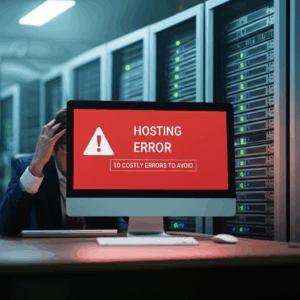- Common Hosting Mistakes That Can Cost You
- Avoiding Costly Hosting Mistakes: Best Practices
- Key Considerations When Choosing a Host
Hosting Mistakes: 10 Costly Errors to Avoid
Hosting mistakes can significantly impact your website’s performance, security, and ultimately, your bottom line. Choosing the right hosting provider and managing your server effectively are crucial for online success. Overlooking seemingly minor details can lead to significant problems down the road. This article outlines ten common hosting mistakes that can be costly and how to avoid them.
Common Hosting Mistakes That Can Cost You

1. Choosing the Wrong Hosting Plan: One of the most fundamental hosting mistakes is selecting an inappropriate hosting plan. Opting for shared hosting when your website requires the resources of a VPS or dedicated server can lead to slow loading times, frequent downtime, and a poor user experience. Conversely, investing in a high-powered dedicated server when a shared plan suffices is an unnecessary expense. Carefully analyze your website’s traffic, resource needs, and future growth projections before settling on a plan.
2. Neglecting Website Security: Security breaches can be devastating, resulting in data loss, reputational damage, and financial losses. Failing to implement robust security measures is a critical hosting mistake. Ensure your hosting provider offers essential security features such as firewalls, malware scanning, and intrusion detection. Regularly update your website’s software, use strong passwords, and consider implementing two-factor authentication.
3. Ignoring Website Backups: Data loss can occur due to various reasons, including hardware failure, hacking, or accidental deletion. Not having regular backups is a grave hosting mistake. Choose a hosting provider that offers automated backups and ensure you have a reliable backup and recovery strategy in place. Test your backups periodically to verify they are working correctly and that you can restore your website quickly in case of an emergency.
4. Overlooking Scalability: Your website’s traffic may fluctuate, and failing to anticipate growth can lead to performance issues during peak periods. Choosing a hosting solution that doesn’t offer easy scalability is a significant oversight. Consider cloud hosting or VPS options that allow you to quickly scale resources up or down as needed, ensuring consistent performance regardless of traffic surges.
Avoiding Costly Hosting Mistakes: Best Practices
5. Not Optimizing Website Performance: Slow loading times can deter visitors and negatively impact your search engine rankings. Failing to optimize your website for performance is a common hosting mistake. Implement caching mechanisms, optimize images, minify CSS and JavaScript files, and leverage a Content Delivery Network (CDN) to accelerate content delivery. Regularly monitor your website’s speed and identify areas for improvement.
6. Poor Server Management: Even with a robust hosting plan, neglecting server maintenance can lead to performance issues and security vulnerabilities. Regularly update server software, monitor server logs, and optimize server configurations for optimal performance. Consider managed hosting services if you lack the technical expertise to handle server management effectively.
7. Choosing a Provider with Poor Customer Support: When issues arise, reliable customer support is crucial. Opting for a hosting provider with inadequate or unresponsive support can be frustrating and time-consuming. Research a provider’s reputation for customer service and ensure they offer multiple support channels, such as phone, email, and live chat, with readily available documentation and resources.
8. Not Monitoring Website Uptime: Downtime can cost you revenue and damage your reputation. Failing to monitor your website’s uptime is a critical mistake. Use website monitoring tools to track uptime and receive alerts when your website goes offline. Choose a hosting provider that guarantees a high uptime percentage and has robust infrastructure to minimize downtime.
Key Considerations When Choosing a Host
9. Disregarding Server Location: Server location plays a significant role in website speed and accessibility for your target audience. Choosing a server located far from your primary audience can lead to increased latency and slower loading times. Select a hosting provider with data centers strategically located close to your target audience to ensure optimal performance.
10. Failing to Read the Fine Print: Before committing to a hosting provider, thoroughly review their terms of service, including their acceptable use policy, refund policy, and service level agreements. Overlooking these details can lead to unexpected costs, limitations, and disputes down the road. Understanding the terms of service will help you avoid unpleasant surprises and ensure a smooth hosting experience.
By avoiding these common hosting mistakes and implementing the best practices outlined above, you can ensure your website performs optimally, remains secure, and delivers a positive user experience. Investing time and effort in selecting the right hosting solution and managing it effectively is essential for online success.











Leave a Reply